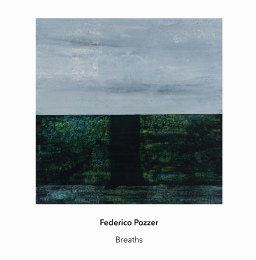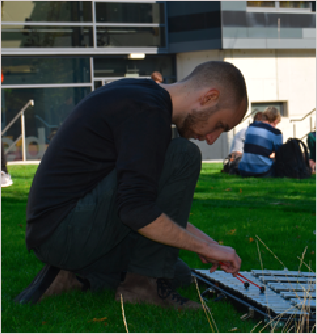Another Timbre TimHarrisonbre
at141 Federico Pozzer ‘Breaths’
1 - Breath II (2017) 34:08
Federico Pozzer, piano Lucio Tasca, guitar
2 - Noises (2018) 10:34
Federico Pozzer, piano Lucio Tasca, guitar, Dejana Sekulić, violin
Colin Frank, vibraphone Kathryn Williams, flute Brice Catherin, cello
3 - Meetings (2018) 16:31
Federico Pozzer, piano Lucio Tasca, guitar, Dejana Sekulić, violin

Interview with Federico Pozzer
Tell us about your background in music.
I started classical piano when I was 8 and then around the age of 15 I got into improvised music. I studied jazz both privately and at the Conservatory of Vicenza, close to my hometown, in Italy. In 2013 I moved to Groningen in Holland, where my musical interests definitely started to change. I really got into Misha Mengelberg, the ICP Orchestra and the free improv scene, and I wrote the first pieces that could not be really identifiable as jazz pieces. However, a couple of years later I discovered Feldman, and later on Bunita Marcus and Cage, and I just started to be very interested in their stuff. In 2016, I eventually moved to Leeds to attend the Critical and Experimental Composition Master Course led by the composer Scott McLaughlin. There I felt immersed in a very stimulating musical environment, and also a quite new one for me. We were encouraged to work on our own compositional research but at the same time we got to know the music of Cardew, Oliveros, Wolff, James Saunders, G Douglas Barrett, Gavin Bryars etc. That was really exciting.
Can you say a bit about how 'Breath II' works? And how did you become interested in breathing patterns?
Well, in this piece breathing acts as a time regulator. Each breath is divided into three different phases: inhaling, exhaling, and a pause. In the piece these three phases basically work as time cycles, flexible and mutable bars. Both piano and guitar are playing one action within each phase, so the musicians have to be constantly aware of their own breathing. The thing is that breathing is flexible; it contracts or stretches according to the player, and the lengths of the breathing phases are not the same for each player. Consequently this approach brings to the surface indeterminate and always changing combinations of sounds of different durations.
Honestly, I am not really sure how I became interested in that. My first ‘breathing pieces’ were written at the end of 2016 or the beginning of 2017. Back then, I think I was looking for a solution that could overcome both the players’ freedom in decision-making and the strictness of the score. What I wanted was to lead musicians towards a grounded connection with the temporal dimension of their playing, and a more present way of making music, and I thought that asking them to match musical actions to breathing could be a useful way of achieving this kind of situation.
Yes, I think it’s very effective, and gives an interesting, staggered rhythm to the music. But what about the tones themselves – how did you determine them in this piece? There are obviously certain notes and intervals that are repeated, but is there a system or is it intuitive?
Basically the score has the following structure: A,B,C,D,E,F,E’,D’,C’,B’,A’ and in this recording we repeat it three times. The amount and the types of sounds per section are the same for both instruments, though in the piano part the order of sounds is reversed. About the tones, the score includes a series of symbols, that can indicate explicit melodic intervals, registers, harmonics, glissandi etc. However pitches are never specified, they are completely up to the players. Before the beginning of the performance, the pianist and guitarist should arrange their own set of sounds independently and once decided, the musicians should always keep the same sounds every time the symbols recur in the score. The melodic intervals are all ninth intervals related together through half-step motions.
Tell us about ‘Meetings’, which also uses breathing patterns. How does that one work?
‘Meetings’ works differently from ‘Breath II’ in that it involves a higher degree of interaction between musicians, with different musicians ‘leading’ the music at different points according to instructions in the score. Depending on the section, one or two of the musicians are asked to change note when they hear the exhalation of the lead player, so they are pushed to listen carefully, while the musician who is leading at any time has to make clear to the other(s) that she/he is exhaling. When they are not interacting, musicians repeat the same pitch following the tempo given by their own breathing. What interested me was the fact that when players are not asked to communicate with each other, they breathe normally, in their own way. However, when musicians interact with each other, their breathing is in some way shaped by the responsibility to the others, by the need to be heard by the other players.
In terms of pitches, each musician plays following a specific major descending or ascending scale: guitar Bb, violin D, and piano F#. However, the fact that musicians’ playing is always combined together makes these specific tonal centers hardly perceivable by the listener. In certain circumstances, the number of notes played by the lead player can also affect the number of notes the other musician(s) will play, so the duration of these notes change according to the length of the lead player’s exhalation and his/her choices.
And what about ‘Noises’, how is that organised?
‘Noises’ is actually the only piece where just one of the musicians in the ensemble plays according to their breathing patterns. While the pianist’s notes last the length of his/her inhalation or exhalation, the other musicians play when they hear external sounds from the environment, both within the hall and from outside. So, the piece is played with the doors and windows of the performance space open. Depending on the type of sound-source that produces an extraneous sound (inanimate or animate object), the musicians react in different ways (changing playing technique, or changing instrument in the case of the percussionist). However, all the players follow the chromatic scale.
The instructions in the score are simple in themselves but open to interpretation. For example, regarding the type of response to external sounds, the performer may wonder ‘if a sound repeats, should I always react to it’? or ‘if two different sounds are heard at the same time, let’s say almost overlapped, should I react to both?’ So, the number of reactions might be quite different between players. On the other hand, I was very concerned about the immediacy of the response; I wanted players to react in a relaxed and controlled way. The awareness of the musical-action should always be present and the musicians that played in the recording on the CD did a really great job with this.
